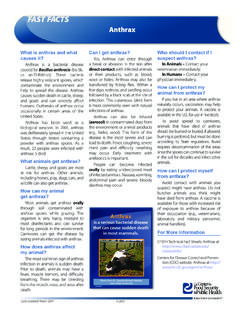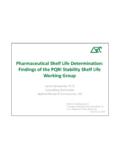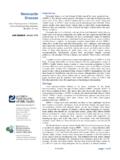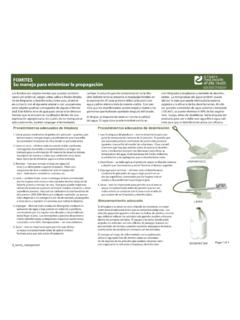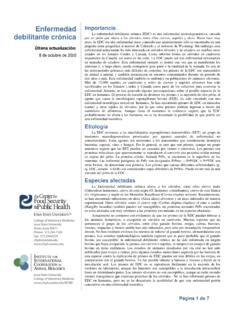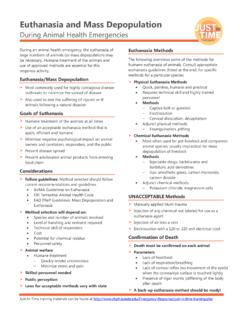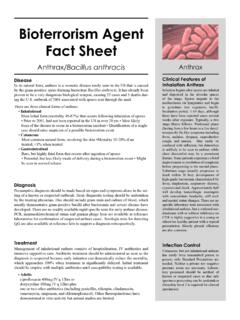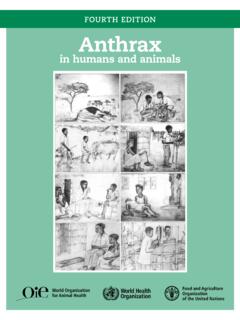Transcription of Anthrax Importance - Iowa State University
1 Email: 2003-2017 page 1 of 12 Anthrax Woolsorters Disease, Cumberland Disease, Maladi Charbon, Malignant Pustule, Malignant Carbuncle, Milzbrand, Splenic Fever, Siberian Fever Last Updated: December 2017 Importance Anthrax is a serious zoonotic disease that affects mammals and, rarely, birds. It is caused by a spore-forming bacterium, Bacillus anthracis, which animals usually acquire from contaminated vegetation, soil or feed products such as bone meal. Anthrax spores are extremely resistant to inactivation, and they can potentially survive in the environment for decades. Species of animals differ in their susceptibility to Anthrax : domesticated and wild herbivores tend to be very susceptible and often die rapidly, while omnivores and carnivores are more resistant to developing clinical signs, and may recover without treatment if they become ill.
2 In endemic regions, Anthrax can be a serious problem in unvaccinated ruminants. Epizootics in wildlife are also a concern, and can kill large numbers of susceptible ungulates. People usually develop Anthrax after exposure to infected animals and animal products. Outbreaks are possible, although clinical cases often occur infrequently and sporadically as an occupational hazard among veterinarians, agricultural workers and people who process hides, hair, wool and bone products. Cutaneous Anthrax accounts for more than 95% of natural infections, and it is rarely fatal if treated with appropriate antibiotics.
3 The gastrointestinal form is less common but more serious, and typically occurs after eating contaminated undercooked or raw animal tissues. Inhalational Anthrax is the most serious form of Anthrax , and the case fatality rate is high unless it is treated early. Natural cases of inhalational Anthrax are rare; however, Anthrax has been used as a weapon by bioterrorists, and weaponized Anthrax can form aerosols readily. An uncommon form of Anthrax , caused by injecting B. anthracis spores, has been reported recently in Europe, where it has been associated with contaminated heroin. Etiology Anthrax results from infection by Bacillus anthracis, a spore forming, Gram positive aerobic rod in the family Bacillaceae.
4 Fully virulent B. anthracis isolates have two plasmids: pX01, which codes for a tripartite protein exotoxin complex, and pX02, which encodes the capsule genes. B. anthracis is a member of the Bacillus cereus sensu lato group, which also contains the closely related organisms B. cereus and Bacillus thuringiensis, as well as a few other species. A few B. cereus isolates that contain plasmids closely related to pX01 have caused Anthrax -like diseases. Isolates that carry both pX01 and pX02-like plasmids have been termed Bacillus cereus biovar anthracis. Studies suggest that this organism may be as virulent as B. anthracis. B. cereus that have only a pX01-like plasmid, but can produce a capsule with other genes, can also cause similar illnesses.
5 Species Affected Virtually all mammals can contract Anthrax , but susceptibility varies widely. Most clinical cases occur in domesticated and wild herbivores. Cases of Anthrax are common in cattle and small ruminants, and they have also been reported in water buffalo, horses, camels and South American camelids. Pigs, other omnivores and carnivores are more resistant to disease, but they can become ill if the dose is high. Outbreaks have been reported in mink and wild species in zoos, as well as in free-living wildlife. Birds appear to be highly resistant, although a few clinical cases have been seen.
6 Species that were affected included ostriches, poultry, eagles and pigeons. B. cereus biovar anthracis is also likely to have a broad host range. As of 2017, this organism has been documented in several species of nonhuman primates (including chimpanzees, Pan troglodytes), duikers (Cephalophus spp.), mongooses (family Herpestidae) and porcupines (family Hystricidae). Other B. cereus that carry Anthrax -like plasmids have not yet been reported in naturally infected animals. Zoonotic potential Clinical cases in humans are mainly caused by B. anthracis, but a few illnesses resulted from infection by B. cereus isolates containing pX01-like plasmids.
7 B. cereus biovar anthracis has not yet been reported in people, although there is no reason to think that humans are not susceptible to this organism. Anthrax 2003-2017 Email: page 2 of 12 Geographic Distribution Although B. anthracis has been found on most continents and some islands, Anthrax is only endemic in limited areas. In general, outbreaks are more common in areas characterized by alkaline soils rich in calcium and other minerals. In domesticated animals and people, Anthrax is particularly common in parts of Africa, Asia and the Middle East where control measures in animals are inadequate.
8 It also occurs in South and Central America. This disease is infrequently reported in North America and Europe. In Europe, it is mostly seen in the south, while cases in North America currently occur in limited foci in western and midwestern states and in parts of Canada. Wildlife cycles have been documented in some regions, such as Africa and North America. Bacillus cereus biovar anthracis has been found in tropical forests of sub-Saharan Africa, where surveys suggest it may be widespread. Similar organisms that have only pX01-like (toxin) plasmids have been reported from human cases in several southern states (Florida, Texas, Louisiana).
9 A similar B. cereus causing Anthrax -like cutaneous lesions was found in India. Transmission Anthrax is usually transmitted by bacterial endospores, although vegetative cells might establish infections in some forms of Anthrax ( , the oropharyngeal form acquired by eating contaminated meat). Animals are mainly thought to become infected when they ingest spores; however, inhalation could also play a role, and entry through skin lesions may be possible. While the vegetative cells of B. anthracis are destroyed in the acid environment of the stomach, spores are resistant to digestion and can germinate when they reach the intestines.
10 Animals, including herbivores, must eat fairly large doses of B. anthracis to become infected by the oral route. Herbivores usually acquire spores from soil or plants in pastures; however, contaminated feed ( , forage, bone meal) has been responsible for some outbreaks outside endemic areas. Other routes of transmission may also be possible. At least one case of Anthrax mastitis was reported in a cow, with the organisms likely to have gained entry through the teats. In most cases, animals that recover from Anthrax are thought to completely eliminate the bacteria. Limited evidence suggests that prolonged localized infections might be possible in some species.
